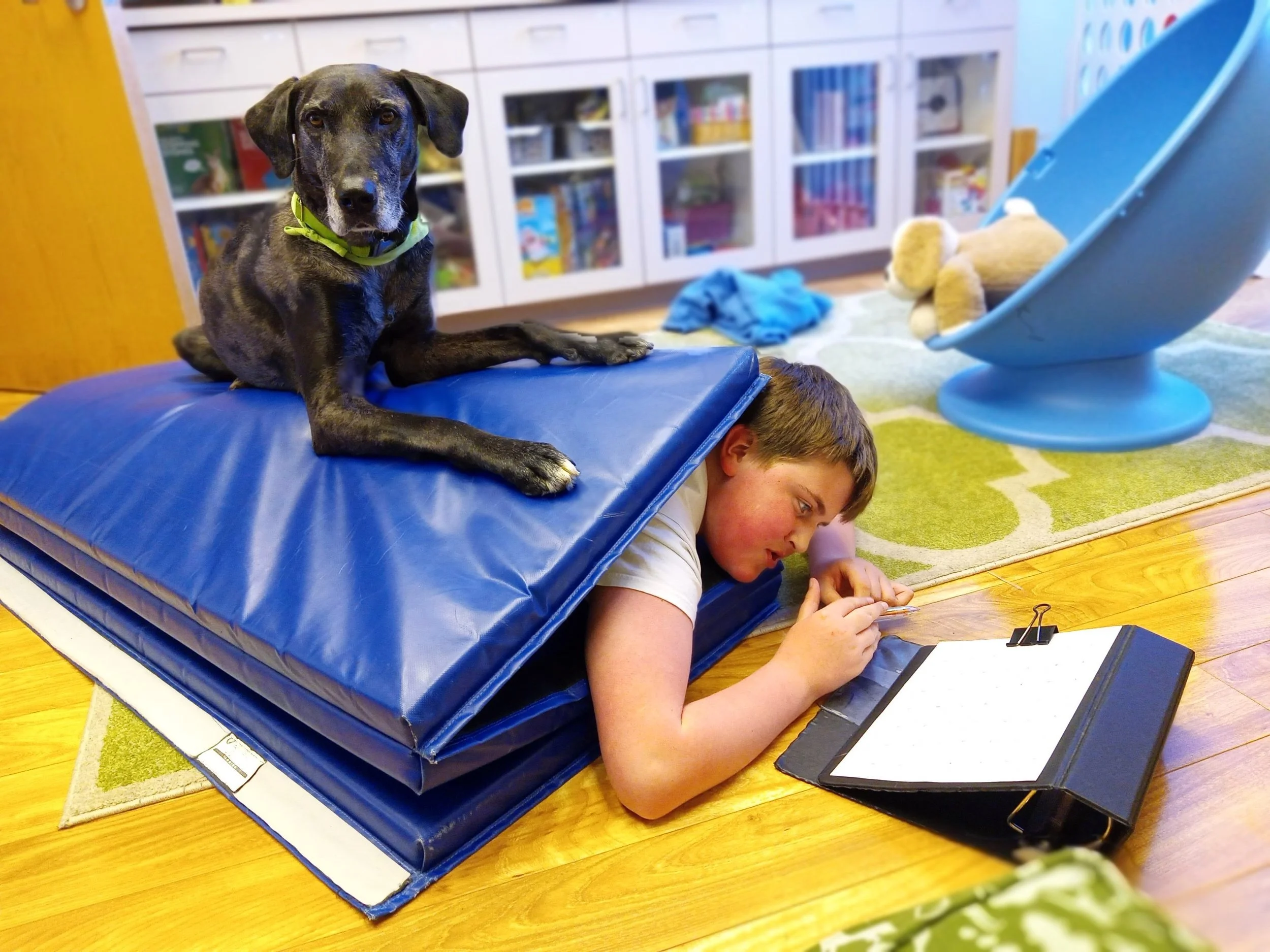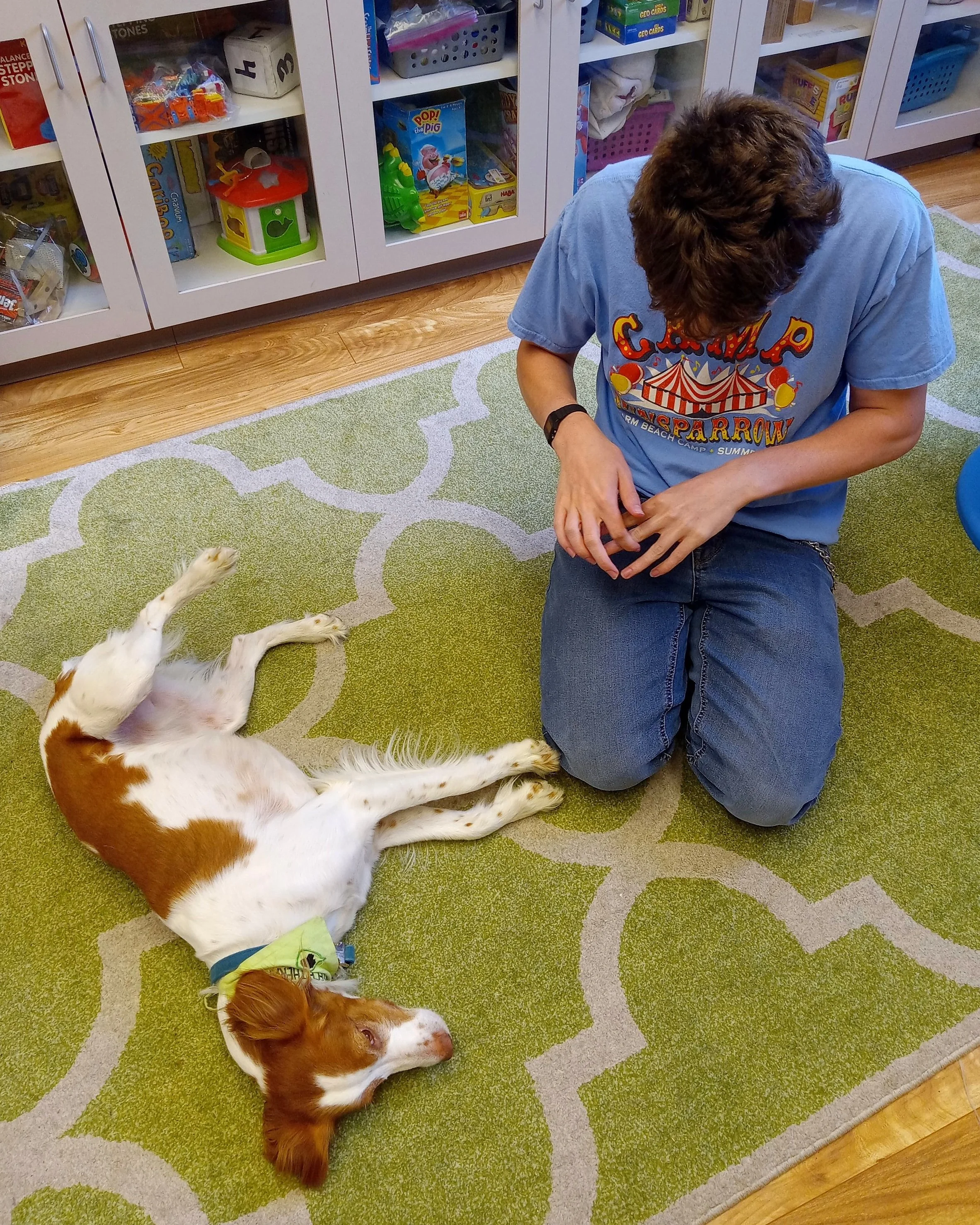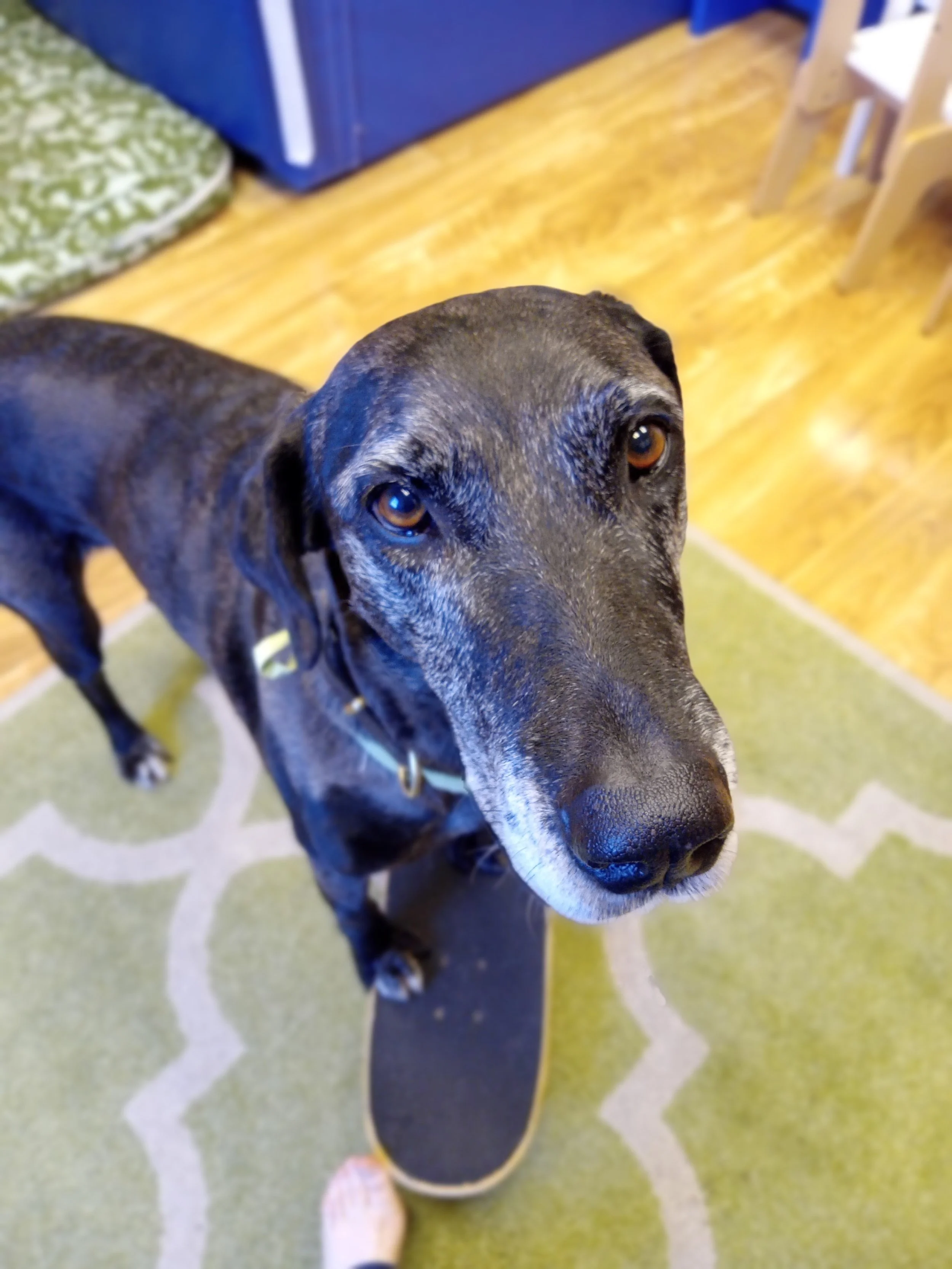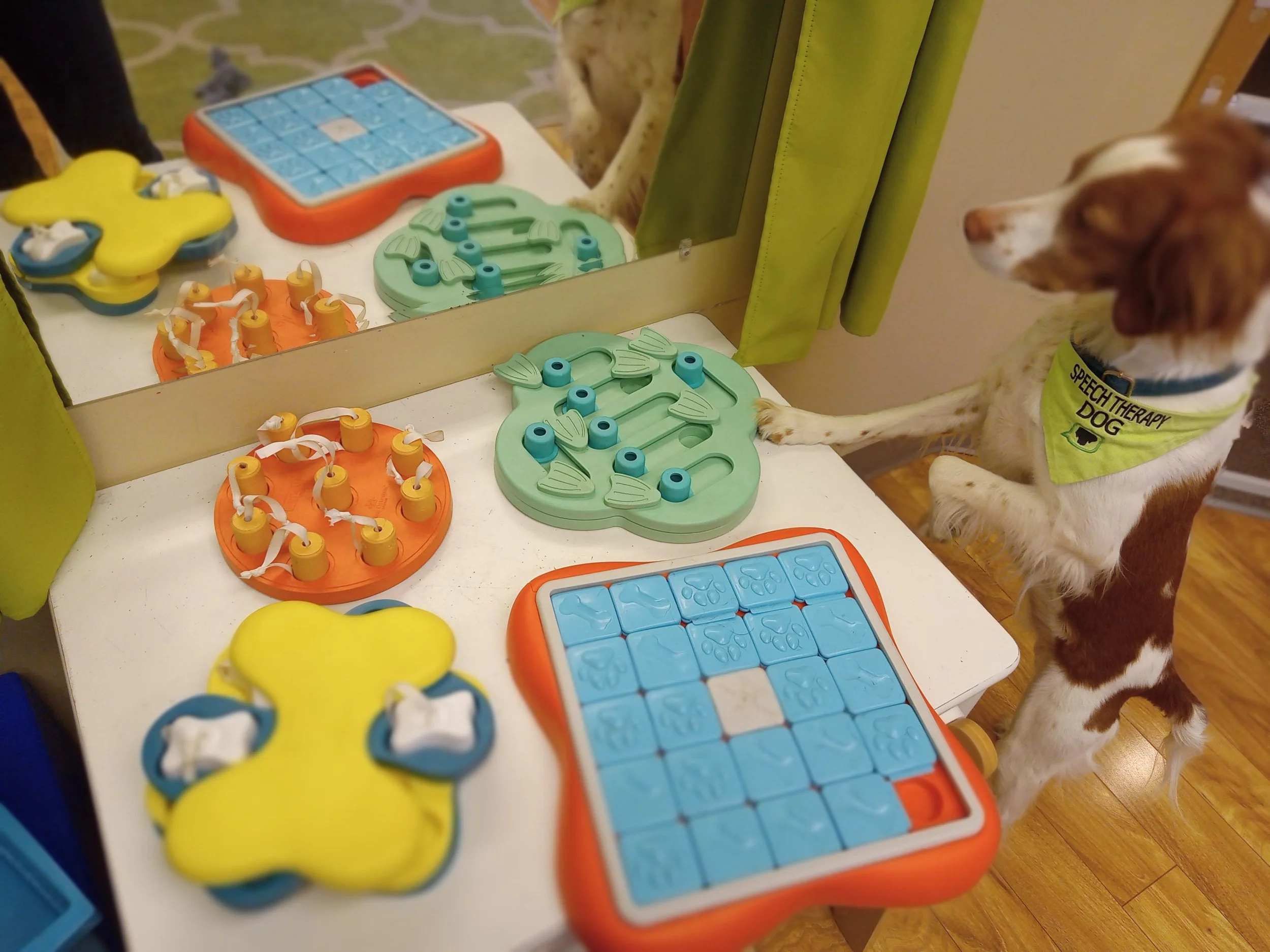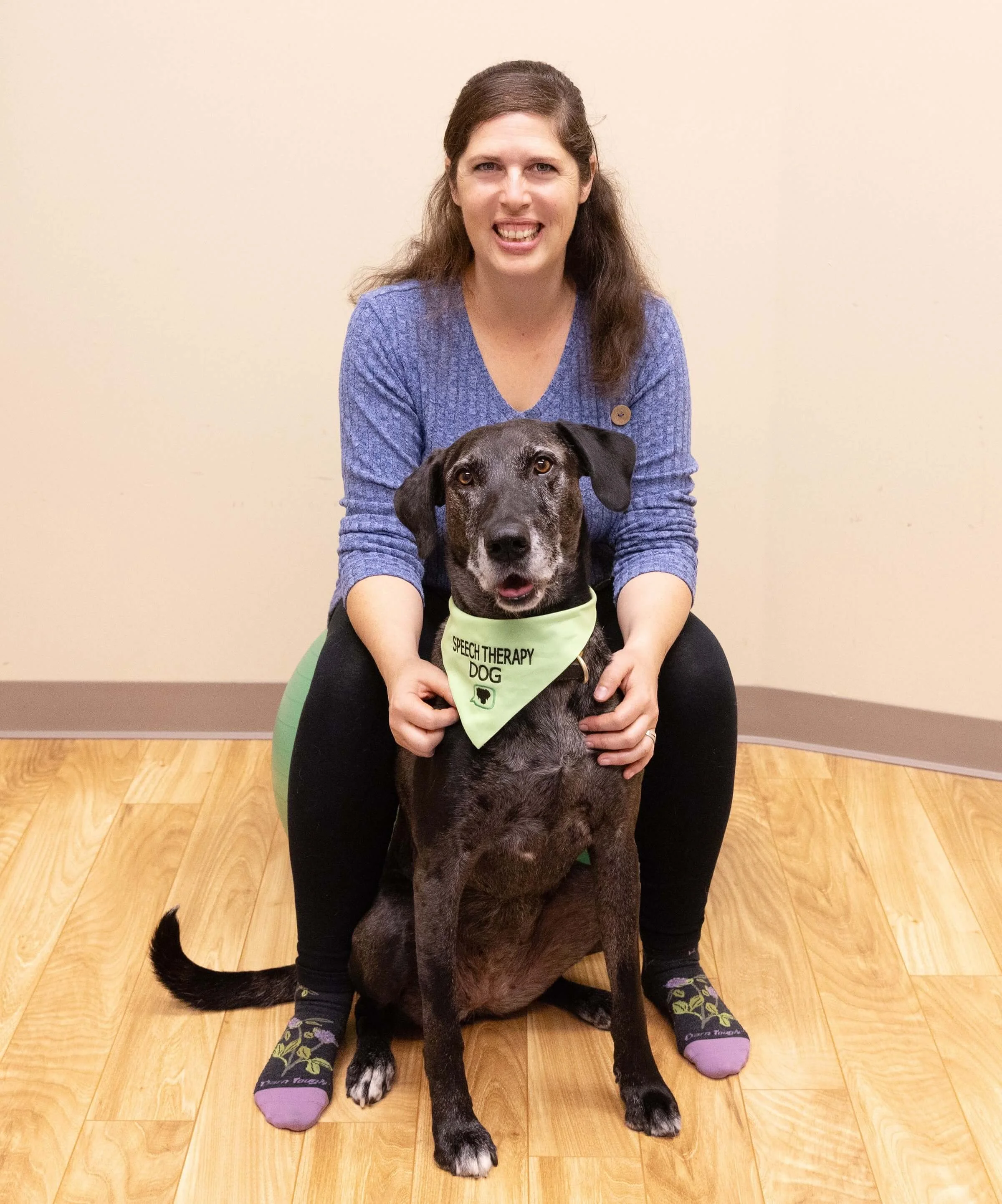From Dysregulation to Connection: A Therapy Dog’s Unexpected Role in A Crisis
The session was rough. Not in a dog-friendly, “r-u-f-f” kind of way, but capital R-O-U-G-H, rough.
And of course I had Delta with me that day.
While more experienced than little Sky, Delta’s temperament is much more sensitive and she has a harder time moving past difficult moments, becoming clingy and needing a lot of reassurance if she doesn’t feel she’s been successful in an encounter.
In short, she’s a worrier.
Her empathic nature is incredibly helpful when working with anxious kids, but it means a lot of management on my part to make sure she thoroughly decompresses between sessions and feels pride in her job.
Speech therapy dog Delta relaxing during a more typical animal-assisted speech therapy session.
If you click a link it may be an affiliate link and I will earn a small commission. It doesn’t cost you anything extra. If I don’t use and love a product you won’t find it here!
Sky, in contrast, lives moment to moment. Something stressful happening? Sky will give more obvious signals of acute stress (circling, lifting a paw, looking away repeatedly, licking her lips and/or yawning), but then as soon as the moment passes she gives a full-body shake to discharge that bad energy and then for her it’s a brand new day.
Our first client of the morning had come in calmly, but about five minutes into the session was hitting his head with his fist, swiping things off any surface he could reach, and making loud repetitive guttural grunts. Major dysregulation, of a degree I hadn’t seen with this young autistic man in years. I grabbed my visual menu of tools to get “ready to work” (i.e., calm and regulated), a self-advocacy tool we’ve used together extensively, and the boy immediately chose “squishes”, deep-pressure input from Delta.
A favorite sensory-regulating activity I incorporate into many sessions every day, speech therapy dog Delta is a master “squisher” and eagerly climbs on top of a safety mat. Here she provides deep pressure input to a reading therapy client.
But as we readied the “squish mat”, the boy’s chewy tube (another calming tool he had chosen) went flying forcefully across the room. He then lunged at me and it was clear it was not safe in that moment for Delta to be closer. Not safe for her and not safe for the boy should she feel a need to defend herself.
So I asked her to back and up and perform a down-stay, praising her from a distance while helping my client calm back down for the next 20 minutes or so until I felt sure it was safe for Delta to return to his side.
(Note: Delta generally has free-choice within sessions to be as close or far from a child as she wishes. With her affiliative nature and especially with this young man with whom she is quite bonded, she typically chooses to sit or lie near clients while we work. Learn more about this in a recent study on the impact of free-choice vs. forced touch with therapy dogs)
For this animal-loving young man, incorporating the therapy dogs has been the biggest game-changer for our work together and usually the most powerful regulating approach I have.
So how could I capitalize on his love for dogs in general and Delta specifically without allowing direct contact for the moment?
Keep reading to find two strategies we successfully implemented during this crisis session as well as another I’ve found helpful in sessions with other children. I’ll also address how I addressed Delta’s (and my) need to decompress after this unusual session…
“Let’s show Delta”: taking off the pressure of direct interaction by talking to the speech therapy dog
I’ve often found a therapy dog can become a neutral third party to decrease the pressure of demands perceived by a child in a dysregulated state. Sometimes that means asking a child to do something I want/need them to do under the guise of doing it to help the dog. I might ask:
· “Can you show Delta where this toy goes?” to encourage clean up time
· “I wonder if Sky has read this book before?” to get the child to approach the reading area
· “I wonder if Delta needs to go potty?” to get the child to transition out of the office
With today being a period of extremely heightened resistance, however, I wasn’t even trying to direct a specific behavior. I just wanted to take off as much pressure as possible while still keeping everyone safe.
So I kneeled a short distance away and directed my eye gaze at Delta, while watching the client in my peripheral vision in case anything else should go flying. And I quietly directed my words toward Delta, using words and phrases he could imitate if he chose to describe feelings and options for calming tools while adding in several slow, deep breaths between sentences.
Once I had his attention, I added in my new favorite breathing technique, “finger breathing.”
Being careful to turn my hand and eyes towards Delta, I modeled tracing each finger on my hand with a slow breath in through my nose as I went up one side, pausing at the finger tip, then blowing the air slowly out my mouth as traced down the other side. Five times on my left hand, then five times on my right hand.
A child demonstrates “finger breathing” to Sky during an animal-assisted speech therapy session. By talking to a therapy dog instead of an adult, a child may feel less pressure and can begin to calm down.
While he wasn’t yet actively imitating, I could feel I had the boy’s attention. So I suggested, “let’s show Delta our finger breathing,” and started again.
Together we did this over and over until he began to spontaneously call Delta’s name and attempt to actually trace his own fingers while breathing. It wasn’t perfect, but it was a start. And his attention had shifted from feeling anger to curiosity about a shared activity. (More commonly we pet Delta in time with slow breathing routines, so finger breathing was a fairly novel activity for this particular boy.)
At this point, with the tension broken, I felt it was time to try to redirect attention by adding in a bit of humor…
A little artful distraction with help from a talented therapy dog
Delta kinda-sorta rides a skate board. It’s not the fluid grace you see in videos of bulldogs, but more of a “I’ll try anything if it means I get a treat” little push-off usually followed by the board flipping on its side as she hops back off a yard or so later.
But it’s a consistent winner in getting chuckles from kids and caregivers alike.
So out came the skateboard.
And immediately thereafter came repeated directions, “Delta, skateboard” spoken by a now entranced young man. So grabbing additional treats for reinforcement, Delta skated back and forth along the edge of the waiting room until we all felt calm enough to go sit in the therapy room and start the activities I had planned.
Speech therapy dog Delta demonstrates her less-than-graceful but nonetheless entertaining skateboarding skills to add humor to an otherwise tense session.
A third technique from working with selective mutism
Though I didn’t specifically incorporate it today, I have found with a couple kiddos who exhibited selective mutism I could get more engagement and establish better rapport by reading a book to my therapy dog with no specific pressure for the child to talk.
Similar to the first technique above, I will grab an especially engaging book and sit next to my dog and just start reading. Leaving a clearly defined space or chair to entice the child to come sit with us. However I give no direct instructions to the child, leaving them to observe from as near or far as they feel comfortable.
If I have a book handy that addresses a specific speech or language goal I’ve identified that’s great. But when in doubt I rely on a few old favorites such as The Rattletrap Car, Is Your Mama A Llama, Fortunately, or That’s Good! That’s Bad! These have a degree of mystery (what will happen next?!?), rich illustrations, and a soothing rhythmic pattern that most kids love.
By reading the book and adding comments without directly looking at the child, I’ve found they will often start participating on their own. If they point to a picture or make a comment, I restate the child’s participation in a comment to my therapy dog. “Sarah just showed us the chicken nest in the car. We like chickens, too.”
By talking to my dog it’s far more natural and less suspicious than if I were talking to myself, reducing the anxiety all around. And historically I’ve found including a caregiver with child who is non-speaking due to anxiety (vs. true ability) tends to backfire at this stage as the adult usually naturally pushes the child for participation.
Decompression: A can’t miss tool for therapy dog welfare
While the session with my autistic teen wasn’t great, we did end productively. But I knew my priority as he left wasn’t cleaning up or writing data as it might typically be, but instead helping Delta release any pent-up stress or frustration she was feeling.
For Delta, this ideally means walks to sniff around as much as possible and plenty of chewing on her special treats.
Unfortunately I had another family already on the way in. So I chose to quickly scatter a handful of favorite treats around the floor to allow her to search out food and switch her brain from thinking to instinctual drive mode for a quick break, followed by a break on her bed with a sunflower butter filled kong.
Sky surveys an array of dog puzzles I incorporate to not only target client goals within animal-assisted speech therapy sessions, but also to aid in therapy dog decompression and enrichment by engaging in natural dog behaviors.
As soon as possible we got in a walk and long-lasting chewer. And after work we went for an extra long walk in which I let Delta stop for as long as she wanted to sniff each interesting spot (a “sniffari” as it’s called in the book The Forever Dog) and to chose which direction we headed at each opportunity to turn.
Because the hormones that cascade through a dog’s body in moment of stress can take hours or even days to fully leave a dog’s body, I’m being cognizant to try to avoid adding additional stressful moments in the coming week to keep her from trigger stacking.
Ultimately we worked past the boy’s crisis moment and he was able to let me know (repeatedly) “Nintendo switch is broken,” a totally novel sentence that explained the feelings of anger he had arrived with.
While I couldn’t do anything about his home game console, it was pretty exciting when his mom confirmed the truth of the statement because it might just be the first time I’ve heard him communicate meaningfully about something that wasn’t present.
And Delta Dawn, my wonderfully patient and understanding therapy dog extraordinaire, was able to feel a part of the session while staying a safe distance away. For a sensitive dog like her that struggles to understand being totally separated from “her” kids, it was the best possible outcome of a difficult situation.
And fortunately, not representative of most of our animal-assisted speech therapy sessions together that are instead usually filled with mutually enjoyable interactions combined with quiet voluntary rest periods on her bed and punctuated with many delicious treats.
If you feel inspired to add a speech therapy dog to your sessions, learn more with the book Paws for Progress: Integrating Animal-Assisted Interventions Into Your Speech-Language Pathology Practice and the online course Talk to the Paw: Foundations for Therapy Animal Inclusion in a Professional Setting.
May your day be filled with puppy wiggles and children’s giggles,
Sharlet
Related articles:


